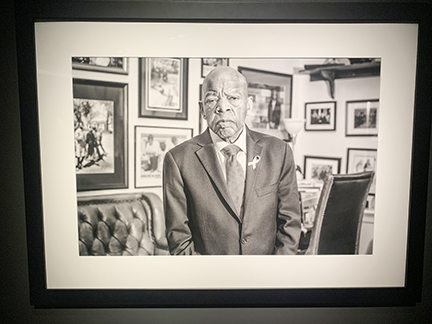By Logan Langlois
NASHVILLE, TN — Under the dim lighting of the Tennessee State Museum exhibition room, standing with his back straight, his arms crossed, and a cancer awareness ribbon on his lapel hangs a portrait of a local civil rights legend and former congressman John Lewis. He grew up attending one of the 4,978 ‘Rosenwald Schools’ founded by Julius Rosenwald and Booker T. Washington that helped change the quality of education available for Black children across America. Lewis’s photo portrait is displayed on a corner of the room overlooking the rest of the exhibit assembled by Andrew Feiler, photographer and author of the 2021 book that informs the exhibition, A Better Life for Their Children: Julius Rosenweld, Booker T. Washington, and the 4,978 Schools That Changed America, with the help of executive director of the Tennessee State Museum Ashley Howell.

The pictures include photos of many former students who attended Rosenweld schools, all of which have a rich story behind them.
“This portrait of Julius Rosenwald has hung inside the Cairo School since this schoolhouse opened in … 1923,” said Feiler, pointing at the top of a photo hanging in the middle of the exhibit while giving a tour.
“Brothers Frank and Charles Brinkley attended this schoolhouse. They went to college, they went to graduate school, they became educators. Frank became a high school math and science teacher. Charles became a middle school principal. They have four sisters, all of whom went through this school, all of whom went to college, and these six siblings have ten children. All ten children went to college. That legacy may not have happened without this schoolhouse.”
“A lot of people are not aware of the history of Rosenwald schools and they were so important to Tennessee,” said the Tennessee State Museum’s Director of Archaeology Debbie Shaw in an interview after the tour. “Especially Tennessean rural African American communities.”

One reason the history of Rosenwald schools, like much Black history in the United States, isn’t well known is because Julius Rosenwald was a modest man who didn’t name the schools ‘Rosenwald schools.’ Rather, the name was given to the schools later. Rosenwald also mandated that all of the money he set aside for the schools should be given within 25 years of his death, as he believed the generation who helps create the wealth should be the generation who reaps its benefits. Therefore, in many cases, it was only the first generation of students who were intimately aware of the name Rosenwald, and the connection the schools had with each other became less known over time.
In researching for the exhibition, Feiler drove more than 25,000 miles and photographed 105 of the remaining schools. Feiler’s book contains 85 images that photograph the interiors and exteriors of schools both restored and unrestored. They also feature portraits of people who were directly tied to the schools, such as John Lewis.
“Julius Rosenwald and Booker T. Washington [were] building schools for African Americans in the Jim Crow south of 1912. That is a deeply optimistic act, that is a multi-generational act,” said Feiler. “I think we have to be optimistic… I think we need to think long-term, and in the immortal words of John Lewis we need to make ‘good trouble.’”
The traveling exhibition originated at the National Center for Civil and Human Rights in Atlanta, Georgia, with The Tennessee State Museum being the current stop on its tour. Additional information is currently available at https://tnmuseum.org/temporary-exhibits, The exhibit itself will be available in the museum until May 21st.



